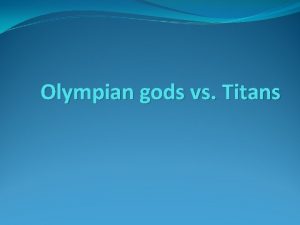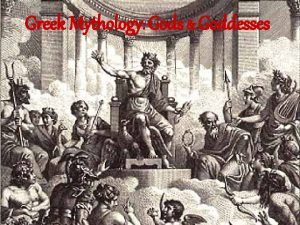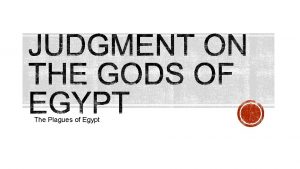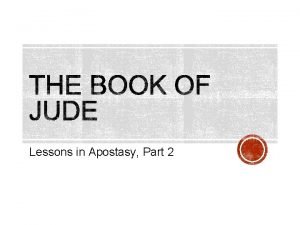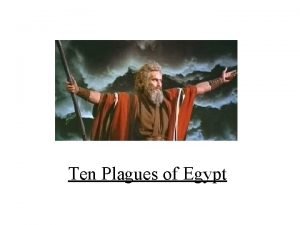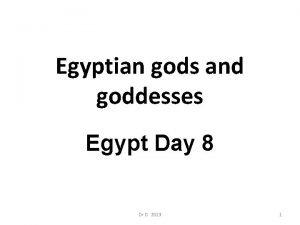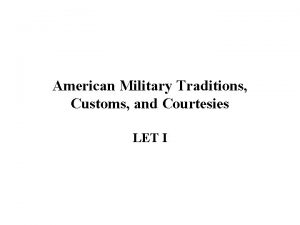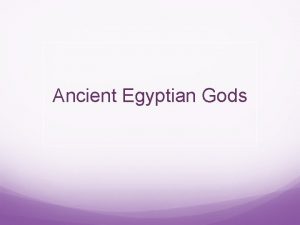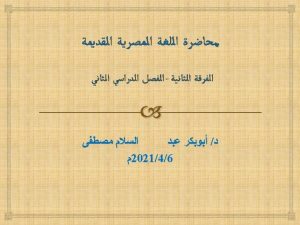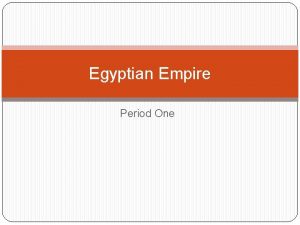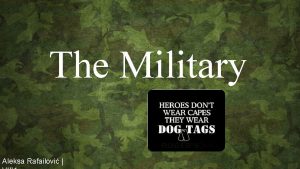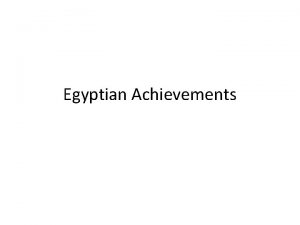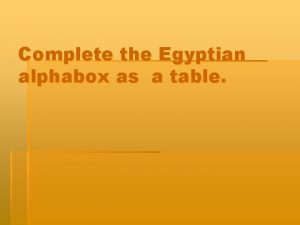Egyptian Military Traditions Egyptian Military Traditions Gods involved





















- Slides: 21

Egyptian Military Traditions

Egyptian Military Traditions -Gods involved in every aspect of Egyptian life, including when it came to warfare. - The Egyptians called upon the gods to ensure their victory. - Egyptians were not typically the most warlike people in the ancient world. - WHY?

Egyptian Military Traditions - The Nile Valley provided for their needs - The deserts on either side served as natural barriers from enemies. -The wealth of Egypt did attract the attention of greedy neighbours. - Egyptians became aware that they would need a strong military force to defend from outside attacks.

Egyptian Military Traditions - Fighting abroad was always viewed with anxiety. Nothing could be worse than getting killed and being buried in a foreign land. - As the Egyptian Army grew stronger they did begin to expand Egyptian borders through conquest.

Egyptian Military Traditions - Egyptian Army was highly trained and disciplined. -Wars were fought with great pomp and ceremony, with trumpeters leading the army into battle - At the head of each attack was the pharaoh's chariot, carrying a flag decorated with a ram’s head and the sun, symbolic of the God Amon-Re.

Old Kingdom • During this period, the king had a personal bodyguard but ancient Egypt had no standing army • When certain regions posed any potential threat, the governors of the various provinces raised troops to defend the empire • Once this temporary army completed a specific military campaign, it was either disbanded or assigned to some other state work project, such as building the pyramids at Giza

New Kingdom • The pharaohs of this period increased the size of their standing armies and concentrated more on building the empire • During Thutmose III, innovations began to appear in Egyptian military • Leather body armour covered with metal scales was introduced • Charioteers, the elite branch of the military, began to carry large shields, and both warrior and horse wore heavy blankets of quilted leather, lined with linen, to cover most of their backs

Types of Weapons • Impact weapons - clubs and mace • Edged close combat weapons – axes, knives and swords • Projectile weapons – bows and arrows, slingshots, javelins, spears and throwing sticks • Defensive equipment – shields, body armour • Transportation equipment – boats, horses, chariots

Impact Weapons • Clubs were perhaps one of the earliest weapons used by Egyptians in warfare • Almost always made of wood, they absorbed shock fairly well and are relatively strong • They are light and only partially successful when used to smash an enemy’s head • Common club was replaced by the mace • A mace is basically nothing more than a wooden club with a head made of some heavy and hard material, such as stone • Use of the mace was limited in regions where armor and helmets were worn during combat

Edged, Close Combat Weapons • Axes were probably used very early in Egyptian warfare • It was the battle axe that eventually replaced the mace as one of the Egyptian military’s primary close combat weapons Long, Piercing Axe head dating to the Middle Kingdom

• Daggers were used as a weapon from the very earliest periods of Egyptian history • Originally made of flint, at no time would the standard dagger have been a very effective weapon against battle axes or even maces, with their long reach • They were adorned as ceremonial objects

• The dagger would eventually lead to a more useful close combat weapon: the sword • Swords were a direct consequence of the introduction of metal • There are no stone predecessors of this kind of weapon • Bronze was first used for making swords A Typical, Late Egyptian Sword Straight, two-edged blade with a sharp point replaced the curved Egyptian swords

Projective Type Weapons • Standoff weapons, usually used in order to soften up the enemy prior to an infantry assault • Throw stick used to some extend during Predynastic period as a weapon, but not very effective • Continued to use it through to the end of the New Kingdom • Used extensively for hunting fowl

Early throwing sticks

• Spear could be either close combat or projectile type of weapon • During old and middle kingdom, it typically consisted of a pointed blade made of copper or flint that was attached to a long wooden shaft • In New Kingdom, bronze blades became common A Bronze Spearhead from Ancient Egypt

Bow and Arrow • One of ancient Egypt’s most crucial weapons • Some of the first bows were “horn bows” made by joining a pair of antelope horns by a central piece of wood • By beginning of dynastic period, bows had a single curvature and were made of wood and strung with sinews or strings made of plant fiber • In pre-dynastic period bows frequently had a double curvature • Old Kingdom, a single-arched bow was adopted

Composite bow • During the New Kingdom, the composite bow came into use, having been introduced by the Asiatic Hyksos • Made from horn, wood, and sinew • A sinew or tendon is a tough band of fibrous connective tissue that usually connects muschle to bone and is capable of withstanding tension • Water buffalo tusks, fish bladders and animal sinew all went into the making of the ancient Egyptian composite bow • Much more difficult and expensive to produce • Difficult weapon to use, demanded strength, dexterity and years of practice http: //www. pbs. org/wgbh/nova/ancient/egyp tian-bow. html

The slingshot • Hurling stones with the help of a slingshot demanded little equipment but considerable practice in order to be effective • Secondary to the bow and arrow in battle, the slingshot was rarely depicted

Shields • From predynastic period to middle kingdom, the only real body protection used by Egyptian soldiers was supplied by a long, roughly rectangular shield made of cowhide stretched over a wooden frame • During the new kingdom bronze was sometimes used. Metal plate shields were heavier than leather shields with wooden frames and did not necessarily afford better protection

Helmets and Body Armor • Egyptians at war rarely covered their heads, the pharaohs being the exception • In Egypt’s Old and Middle Kingdom, Egyptian soldiers never wore armor • Sometimes broad leather bands covered part of the torso of charioteers, but generally soldiers are depicted without any body protection • Again, the pharaohs were the exception

• http: //www. touregypt. net/featurestories/wea pons. htm
 Titans vs gods
Titans vs gods Greek mythology of gods and goddesses
Greek mythology of gods and goddesses 10 plagues and egyptian gods
10 plagues and egyptian gods Shakmet
Shakmet Egyptian easter traditions
Egyptian easter traditions Facts about exodus
Facts about exodus Egyptian gods
Egyptian gods 10 plagues of egypt and egyptian gods
10 plagues of egypt and egyptian gods Exodus 7:14-10:29
Exodus 7:14-10:29 Goddess of moisture
Goddess of moisture Easter traditions in wales
Easter traditions in wales Russian easter 2020
Russian easter 2020 Romans floral design
Romans floral design Military traditions and customs
Military traditions and customs Who were the egyptians
Who were the egyptians Mount st helens plates involved
Mount st helens plates involved Setting channel objectives
Setting channel objectives Initiation steps
Initiation steps Hercules 7th labor
Hercules 7th labor Enzyme involved
Enzyme involved Muscles of inspiration
Muscles of inspiration What countries were involved in wwi
What countries were involved in wwi
